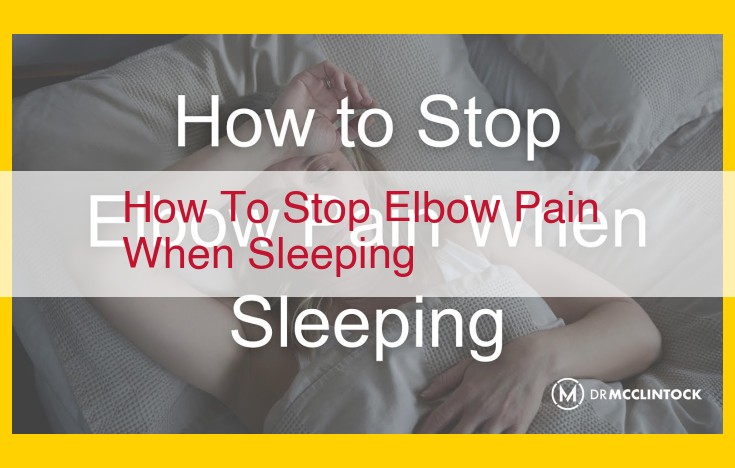To prevent elbow pain when sleeping, consider using elbow rests or pads that decrease pressure on the elbow. Compression sleeves or braces can provide support and minimize stress. Additionally, stretching exercises before bed can enhance flexibility and reduce muscle tension, while strengthening exercises can stabilize the elbow, reducing future pain and discomfort.
Elbow Pain: A Comprehensive Guide to Causes
Elbow pain is a common complaint that can affect individuals of all ages. Understanding the various causes of elbow pain is crucial for effective prevention and treatment.
Ulnar Nerve Entrapment
The ulnar nerve is a major nerve that runs through the elbow region. When this nerve becomes compressed due to conditions like cubital tunnel syndrome, it can cause numbness, tingling, and pain in the forearm and hand. This nerve entrapment can be caused by repetitive hand motions, leaning on the elbow for prolonged periods, or having an underlying medical condition that affects nerve function.
Tennis Elbow (Lateral Epicondylitis)
Tennis elbow is a painful condition that affects the outer elbow. It occurs due to inflammation of the tendons that attach to the outside of the elbow bone. This inflammation can be caused by overusing the wrist extensor muscles in activities like tennis, painting, or manual labor.
Golfer’s Elbow (Medial Epicondylitis)
Similar to tennis elbow, golfer’s elbow affects the inner elbow. It is caused by inflammation of the tendons that attach to the inside of the elbow bone. This condition often arises from overuse of the wrist flexor muscles during activities such as golf, weightlifting, or playing string instruments.
Olecranon Bursitis
The olecranon is a large bone at the back of the elbow. When the fluid-filled sac that cushions this bone becomes irritated and inflamed, it can lead to olecranon bursitis. This condition can result from direct trauma to the elbow, repeatedly leaning on the elbow, or certain infections.
Overuse of the Elbow Joint
Excessive or repetitive use of the elbow joint, especially in activities that involve gripping, lifting, or twisting, can strain and inflame the muscles, tendons, and ligaments surrounding the elbow. This type of pain typically develops gradually over time and is often associated with occupations that require repetitive arm and hand movements.
Contributing Factors to Elbow Pain
Elbow discomfort may arise not only from underlying conditions but also from certain lifestyle factors. Understanding these contributing elements is crucial for preventing and addressing elbow pain effectively.
One prevalent cause of elbow strain is poor posture. When we slouch or hold our bodies in unnatural positions for extended periods, it puts undue stress on our muscles and tendons. This prolonged strain can lead to imbalances and inflammation in the elbow joint.
Repetitive motions, particularly those involving repeated flexion and extension of the elbow, can exacerbate the risk of elbow pain. Activities like typing, painting, or playing sports that necessitate repetitive elbow movements can gradually damage tendons and muscles over time. It’s essential to be mindful of the potential risks associated with such activities and take appropriate precautions to safeguard your elbows.
Prevention of Elbow Pain
Preventing elbow pain is crucial for maintaining optimal joint health. Several effective measures can help you avoid the discomfort associated with elbow injuries.
1. Elbow Rests and Pads:
- Use elbow rests or pads when working at a desk or engaging in activities that require prolonged elbow support.
- These devices reduce direct pressure on the elbow, minimizing strain and inflammation.
2. Compression Sleeves and Braces:
- Wear compression sleeves or braces during activities that involve repetitive elbow movements.
- These supports provide stability, reduce stress on the elbow joint, and improve circulation.
3. Stretching Exercises:
- Incorporate regular elbow stretching exercises into your routine.
- Focus on improving flexibility in the muscles around the elbow, reducing tension and increasing the range of motion.
- Stretches to Consider: Wrist flexor stretch, triceps stretch, and pronator stretch.
4. Strengthening Exercises:
- Engage in strengthening exercises to enhance stability and prevent future elbow pain.
- Strengthen the muscles that support and stabilize the elbow joint.
- Exercises to Consider: Wrist curls, reverse wrist curls, and elbow extensions.
By adopting these preventive measures, you can significantly reduce the risk of developing elbow pain and maintain healthy, pain-free elbows for years to come.
Treatment for Elbow Pain
Elbow pain can be a debilitating condition that interferes with everyday activities. While there are various causes and contributing factors to elbow pain, there are also effective treatments available.
Over-the-Counter Pain Relievers (NSAIDs)
In most cases, over-the-counter pain relievers such as ibuprofen or naproxen can effectively reduce inflammation and alleviate elbow pain. These medications are widely available and can provide temporary relief.
Corticosteroid Injections
If NSAIDs fail to provide adequate pain relief, corticosteroid injections may be considered. Corticosteroids are powerful anti-inflammatory medications that are injected directly into the affected area. They can quickly reduce inflammation and improve pain levels.
Surgery (Rare Cases)
In severe and persistent cases, surgery may be necessary to address underlying structural issues. Surgical intervention is typically considered only when other treatment options have been unsuccessful.
It’s important to consult with a healthcare professional to determine the appropriate treatment plan for your individual case. Early diagnosis and treatment can help prevent further damage and optimize recovery. Remember, if you are experiencing persistent elbow pain, do not hesitate to seek medical attention.
